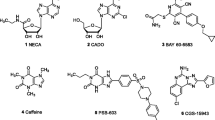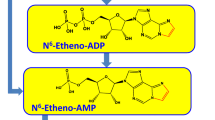Summary
(−)N6-Phenylisopropyladenosine, a potent agonist in adenosine-responsive cellular systems, has been labeled with tritium to high specific activity (26 Ci/mmol) and used to identify adenosine binding sites in rat brain membranes. (−)[H3]N6-Phenylisopropyladenosine binding was studied by a vacuum filtration technique. The binding was rapid, rapidly reversible, dependent on pH and temperature and stereospecific since the (−)isomer of N6-phenylisopropyladenosine was 40-fold more potent than the (+)isomer in competition experiments. The stereospecific binding sites were saturable and bound 0.8 pmol of (−)N6-phenylisopropyladenosine per mg of membrane protein. The dissociation constant (KD) of (−)N6-phenylisopropyladenosine for these sites was 5–12 nM as determined independently by saturation and kinetic binding studies. Endogeneous ligands seem to occupy the binding sites since pretreatment with adenosine deaminase increased the specific binding.
Adenosine and several adenosine derivatives were studied for their ability to compete with (−)[3H]N6-phenylisopropyladenosine binding. (−)N6-Phenylisopropyladenosine-5′-monophosphate, N6-phenyladenosine, N6-benzyladenosine, 2-chloroadenosine and adenosine were most potent in displacing the radioligand from its binding sites and the IC50-values ranged from 0.3–7 μM. Physiologically inactive compounds such as inosine, hypoxanthine, adenine and the ribose-modified analogues 2′-deoxyadenosine and 2′,5′-dideoxyadenosine did not substantially inhibit binding at concentrations up to 100 μM. The adenosine antagonists isobutylmethylxanthine (IC50 3.2 μM), theophylline (IC50 7.6 μM) and caffeine (IC50 99 μM) competed for the binding sites of (−)[3H]N6-phenylisopropyladenosine in a manner which parallels their known pharmacological activity whereas other phosphodiesterase inhibitors were ineffective.
The (−)[3H]N6-phenylisopropyladenosine binding sites in rat brain membranes appear to be equivalent to adenosine receptor sites on the cell surface which have recently been classified as R-site adenosine receptors.
Similar content being viewed by others
References
Alexander RW, Davis JN, Lefkowitz RJ (1975) Direct identification and characterisation of β-adrenergic receptors in rat brain. Nature 258:437–440
Baer HP, Drummond GI (1979) Physiological and regulatory functions of adenosine and adenine nucleotides. Raven Press, New York
Blume AJ, Dalton C, Sheppard H (1973) Adenosine-mediated elevation of cyclic 3′:5′-adenosine monophosphate concentrations in cultured mouse neuroblastoma cells. Proc Natl Acad Sci USA 70:3099–3102
Bünger R, Haddy FJ, Gerlach E (1975) Coronary responses to dilating substances and competitive inhibition by theophylline in the isolated perfused guinea pig heart. Pflügers Arch 358:213–224
Clanachan AS, Johns A, Paton DM (1977) Presynaptic inhibitory actions of adenine nucleotides and adenosine on neurotransmission in the rat vas deferens. Neuroscience 2:597–602
Clark RB, Seney MN (1976) Regulation of adenylate cyclase from cultured human cell lines by adenosine. J Biol Chem 251:4239–4246
Clark RB, Gross R, Su YF, Perkins JP (1974) Regulation of adenosine 3′:5′-monophosphate content in human astrocytoma cells by adenosine and the adenine nucleotides. J Biol Chem 249:5296–5303
Dutta P, Mustafa SJ (1979) Saturable binding of adenosine to the dog heart microsomal fraction: Competitive inhibition by aminophylline. J Pharmacol Exp Ther 211:496–501
Fain JN, Malbon CC (1979) Regulation of adenylate cyclase by adenosine. Mol Cell Biochem 25:143–169
Harms HH, Wardeh G, Mulder AH (1978) Adenosine modulates depolarization-induced release of 3H-noradrenaline from slices of rat brain neocortex. Eur J Pharmacol 49:305–308
Haulica I, Ababei L, Branisteanu D, Topoliceanu F (1973) Preliminary data on the possible hypnogenic role of adenosine. J Neurochem 21:1019–1020
Hedqvist P, Fredholm BB (1976) Effects of adenosine on adrenergic neurotransmission; prejunctional inhibition and postjunctional enhancement. Naunyn-Schmiedeberg's Arch Pharmacol 293:217–223
Heller IH, McIlwain H (1973) Release of [14C]adenine derivatives from isolated subsystems of the guinea pig brain: Actions of electrical stimulation and of papaverine. Brain Res 53:105–116
Hershfield MS, Kredich NM (1978) S-Adenosylhomocysteine hydrolase is an adenosine-binding protein: A target for adenosine toxicity. Science 202:757–760
Hsu HHT (1975) Specific adenosine binding proteins from rat liver. Proc Soc Exp Biol Med 149:698–701
Huang M, Shimizu H, Daly JW (1972) Accumulation of cyclic adenosine monophosphate in incubated slices of brain tissue. 2. Effects of depolarizing agents, membrane stabilizers, phosphodiesterase inhibitors, and adenosine analogs. J Med Chem 15:462–466
Londos C, Wolff J (1977) Two distinct adenosine-sensitive sites on adenylate cyclase. Proc Natl Acad Sci USA 74:5482–5486
Lowry OH, Rosebrough NJ, Farr AL, Randall RJ (1951) Protein measurement with the folin phenol reagent. J Biol Chem 193:265–275
Malbon CC, Hert RC, Fain JN (1978) Characterization of [3H]adenosine binding to fat cell membranes. J Biol Chem 253:3114–3122
Marley E, Nistico G (1972) Effects of catecholamines and adenosine derivatives given into the brain of fowls. Br J Pharmacol 46:619–636
Mueller AL, Mosimann WF, Weiner N (1979) Effects of adenosine on neurally mediated norepinephrine release from the cat spleen. Eur J Pharmacol 53:329–333
Oßwald H (1975) Renal effects of adenosine and their inhibition by theophylline in dogs. Naunyn-Schmiedeberg's Arch Pharmacol 288:79–86
Phillis JW, Kostopoulos GK (1975) Adenosine as a putative transmitter in the cerebral cortex. Studies with potentiators and antagonists. Life Sci 17:1085–1094
Phillis JW, Kostopoulos GK, Limacher JJ (1974) Depression of corticospinal cells by various purines and pyrimidines. Can J Physiol Pharmacol 52:1226–1229
Premont J, Perez M, Bockaert J (1977) Adenosine-sensitive adenylate cyclase in rat striatal homogenates and its relationship to dopamine- and Ca2+-sensitive adenylate cyclases. Mol Pharmacol 13:662–670
Rall TW, Sattin A (1970) Factors influencing the accumulation of cyclic AMP in brain tissue. In: Role of cyclic AMP in cell function. Adv Biochem Psychopharmacol 3:113–133
Sattin A, Rall TW (1970) The effect of adenosine and adenine nucleotides on the cyclic adenosine 3′,5′-phosphate content of guinea pig cerebral cortex slices. Mol Pharmacol 6:13–23
Scatchard G (1949) The attractions of proteins for small molecules and ions. Ann NY Acad Sci 51:660–672
Schubert P, Lee K, West M, Deadwyler S, Lynch G (1976) Stimulation-dependent release of 3H-adenosine derivatives from central axon terminals to target neurones. Nature 260:541–542
Schwabe U, Kiffe H, Puchstein C, Trost T (1979) Specific binding of 3H-adenosine to rat brain membranes. Naunyn-Schmiedeberg's Arch Pharmacol 310:59–67
Smellie FW, Daly JW, Dunwiddie TV, Hoffer BJ (1979) The dextro- and levorotatory isomers of N-phenylisopropyladenosine: Stereospecific effects on cyclic AMP-formation and evoked synaptic responses in brain slices. Life Sci 25:1739–1748
Su C (1978) Purinergic inhibition of adrenergic transmission in rabbit blood vessels. J Pharmacol Exp Ther 204:351–361
Trost T, Stock K (1977) Effects of adenosine derivatives on cAMP accumulation and lipolysis in rat adipocytes and on adenylate cyclase in adipocyte plasma membranes. Naunyn-Schmiedeberg's Arch Pharmacol 299:33–40
Trost T, Schwabe U (1980) Characterization of adenosine receptors in rat brain by 3H-phenylisopropyladenosine. Naunynberg's Arch Pharmacol Suppl 311:R73
Ueland PM, Døskeland SO (1977) An adenosine 3′:5′-monophosphate-adenosine binding protein from mouse liver. Purification and partial characterization. J Biol Chem 252:677–687
Vapaatalo H, Onken D, Neuvonen PJ, Westermann E (1975) Stereospecificity in some central and circulatory effects of phenylisopropyladenosine (PIA). Arzneim Forsch 25: 407–410
Verhaeghe RH, Vanhoutte PM, Shepherd JT (1977) Inhibition of sympathetic neurotransmission in canine blood vessels by adenosine and adenine nucleotides. Circ Res 40:208–215
Westermann E, Stock K (1970) Inhibitors of lipolysis: Potency and mode of action of α- and β-adrenolytics, methoxamine derivatives, prostaglandin E1 and phenylisopropyl adenosine. In: Jeanrenaud B, Hepp D (eds) Adipose tissue, regulation and metabolic functions. Thieme, Stuttgart, pp 47–54
Yuh KCM, Tao M (1974) Purification and characterization of adenosine- adenosine cyclic 3′,5′-monophosphate binding protein factors from rabbit erythrocytes. Biochemistry 13:5220–5226
Author information
Authors and Affiliations
Additional information
This work is dedicated in memory of Erik Westermann (1923–1978) and Klaus Stock (1931–1978) who first described the potent pharmacological effects of N6-phenylisopropyladenosine and stimulated much of the recent interest in adenosine receptor research
Rights and permissions
About this article
Cite this article
Schwabe, U., Trost, T. Characterization of adenosine receptors in rat brain by (−)[3H]N6-phenylisopropyladenosine. Naunyn-Schmiedeberg's Arch. Pharmacol. 313, 179–187 (1980). https://doi.org/10.1007/BF00505731
Received:
Accepted:
Issue Date:
DOI: https://doi.org/10.1007/BF00505731




